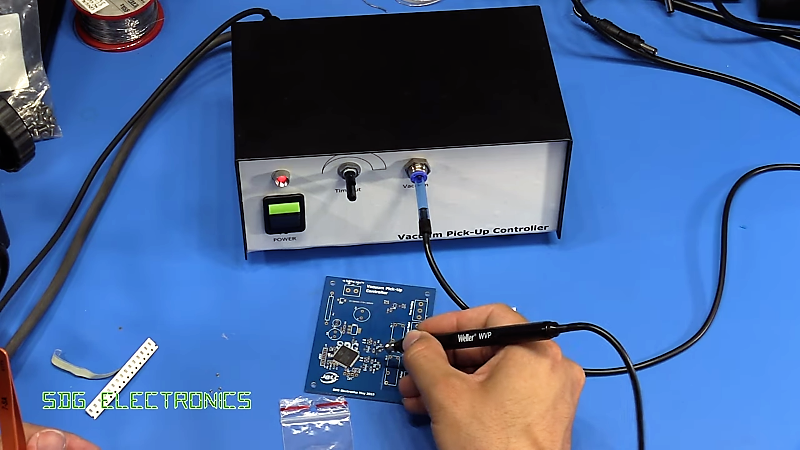The tapes that surface-mount devices come in may be optimized for automated pick and place, but woe betide those who try to dig components out manually. No matter what size package, the well on the tape seems to be just a wee bit too small to allow tweezers to grip it, so you end up picking the thing up edgewise or worse, pinching too tight and launching the tiny thing into The Void. We hope you ordered extra.
Such circumstances are why vacuum handlers were invented, but useful as they are for picking and placing SMDs, they aren’t perfect. [Steve Gardener]’s sub-optimal experience with such tools led him to build this custom vacuum pick-and-place tool. It’s based on an off-the-shelf Weller unit, of which only the handpiece remains. A bigger, more powerful vacuum pump is joined in a custom enclosure by a PCB with a PIC18F13K22 microcontroller, a power supply, a solenoid to control the vacuum, and a relay to switch the pump. A footswitch starts the pump and closes the vacuum vent; letting off the pedal opens the vent to drop the part, while the pump keeps running for a variable time. This lets him rapidly work through a series of parts without having to build vacuum back up between picks. The video below shows the build and the tool in action.
We love the idea of this tool, and the polished look is pretty slick too. If manual pick-and-place isn’t for you, though, maybe converting a 3D-printer into an automated PnP is something to check out.















Top Tip! Don’t buy one of the “Vacuum SMD Pump Suction Vacuum Tweezer Pick Up Silver White G2C2” devices from eBay. They do not work. Not at all. Not even a little bit. Ever.
The only possible use might be to conect to an aquarium pump as a cheap source of a sutable handpiece.
I bought some cheap jank SMD vacuum off Amazon. It’s okay except for the hose collapses most of the time. My main problem is I have a hard time with smaller components. The suction cups or even bare needle is too big (it’ll just suck the smaller stuff into the tube). I have found the glue applicator syringe sets that have many sizes help with this. I also found if you cut some heat shrink and put the cut size onto the needle first and then shrink the straight part just a hair past the metal of the needle it works. I wish I could find the angled needles in more sizes with these premade soft tips. Think some people use some kind of tacky glue but that’s just too slow to mess with for me.
For all those 555 people. Reversed aquarium pump, a length of air line and a biro with a hole in the side.
I work with 0402 routinely, with 0201 – occasionally. Good tweezers are more important than ten vacuum picks. See the reply of k-ww. Take the tape, tear the film off and then flip the tape over a container. Push the parts out with a needle from the other side. They fall into the container and stay there.
Next, take one part with tweezers (use magnifier if needed) and put onto the board near the desired place. No need to position yet. You can do it while looking through a microscope – this is most convenient.
Next, put a bit of solder onto one pad. Push the part into position using single leg of tweezers. Or you can grab with tweezers. No force required. Reheat the soldered pad – part stays in position. Now you can solder another pad or more, and then solder the first pin for good.
The key in this whole business is trivial: tools and experience. Both are needed, tools being more important. You need an optical microscope (Omano, for one) and a Metcal soldering station with a set of tips. Total maybe $1,000 or less, if you buy new.
https://www.jensentools.com/virtual-industries-vcs-9-b-virtual-ind-vacuum-cups-with-probe-set-of-9-b/p/847so009 work well down to 0603 parts. That particular nozzle size seems to be a standard: we use it with two different motorized vacuum systems and another Techni-Stat hand-operated vacuum system where you push a bellows in with your thumb to supply the vacuum so the whole thing’s the size of a large Sharpie marker.
Thanks. That’s the best set I’ve seen and they have some other ones listed too.
Could you explain how the system works. Does it gain suction from a external source?
Yes. These are replacement tips for a variety of vacuum sources. Techni-stat’s Pen-Vac is one, that’s handheld and the vacuum is established or released by compressing a bellows with your hand. They don’t hold very well. Virtual Industries makes a powered vacuum source about 4x4x20cm that works a lot better, and has a nice thin handpiece. I strongly prefer the 30 degree bent suction cup adapters over the straight ones for what I do at work. Excelta also makes a really nice vacuum source but they’re wicked expensive. Worth the money for work, but hard to justify unless you’re testing large quantities of chips that you have to fit in deep automated test sockets, because extracting them while dragging them up the sides of the sockets means weak vacuum sources tend to drop the chip. For just placing parts from a reel onto a board even the pen-vac works fine, especially if you lick it I mean touch it against a wetted sponge. Don’t let the ESD cops see, though.
I dump out the parts from a tape [one value at a time] into a small tray, pick up the right side up ones [resistors, diodes, etc.,
and then us a post-it note to ‘grab’ the upside down ones and invert them –
As for tweezers, I have found the Digikey # 1691-1280 is excelent for manual placement, and at $5.37 not a budget buster.
dump them on a piece of paper, when you tap the paper they jump flip